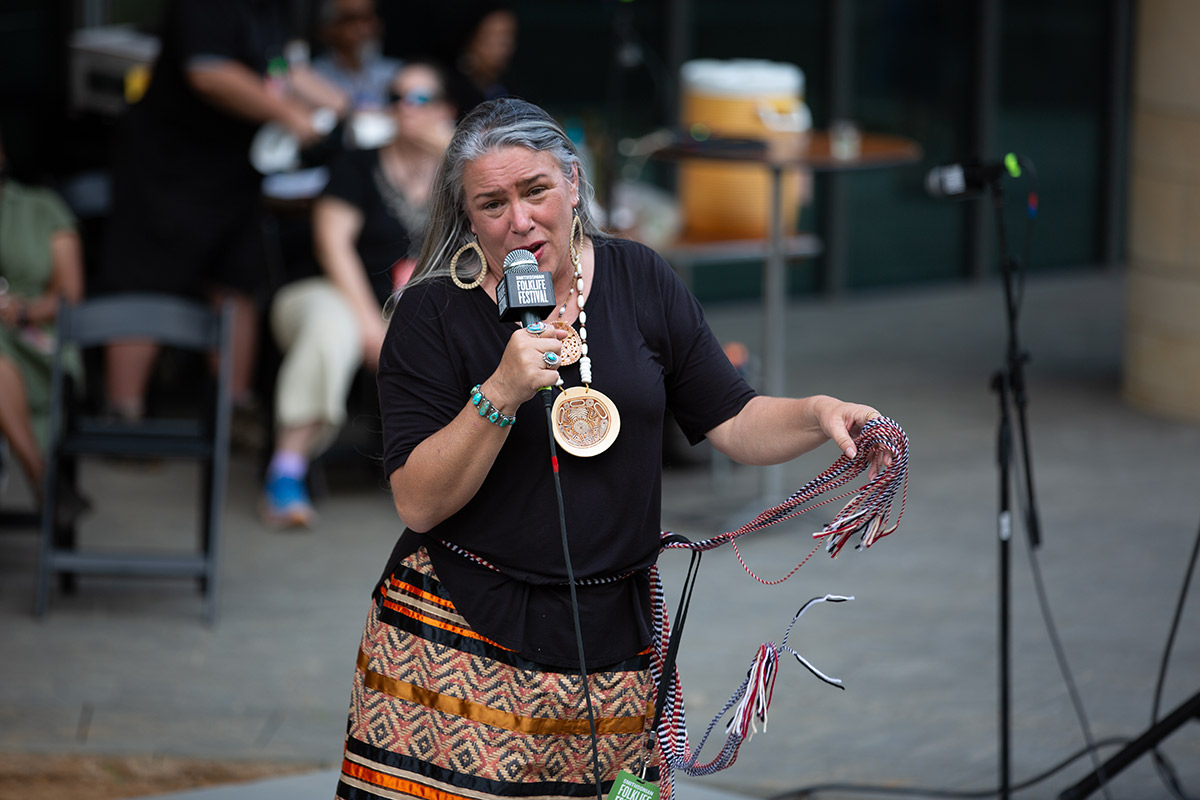
During her storytelling sessions, Amy Bruton Bluemel displayed her Chickasaw woven dance belt, sharing cultural tales over the six days of the 2024 Festival.
Photo by Daniel Martínez González, Ralph Rinzler Folklife Archives
Amy Bruton Bluemel has always collected stories like treasured souvenirs, a passion ignited during her childhood. Growing up, her father, who served in the Navy and later in civil service, moved the family across the globe—from Germany to Türkiye, Scotland, and Japan. Despite the varying cultures she encountered, Bluemel consistently found engaging storytellers ready to share traditional tales.
This love for storytelling was rooted in her family. Her mother, Elizabeth Ann Kaney Bruton of the Chickasaw Nation, possessed an innate storytelling ability, weaving moral tales naturally into conversation. Conversely, her father, a non-Native, entertained the family with grand stories during mundane moments, cultivating a rich narrative environment at home.
Immersed in stories, Bluemel felt an irresistible pull toward the storytellers she met in each new locale.

Photo by James Dacey, Ralph Rinzler Folklife Archives
“In Turkey, I listened to tales of the Hodja; in England, I heard stories of dragons,” Bluemel recalls. “Everywhere I went, the world was filled with narratives and storytellers.”
Upon returning to Texas for high school, she was thrilled to find that the tales she had gathered were widely recognized. Discussions about dragons from England and Asia resonated with many, provoking her curiosity: how come narratives from her own Chickasaw culture were so rarely acknowledged? Growing up, she only heard fragments of those stories from her mother.
The Chickasaw Nation, originally based in what is now Mississippi, Alabama, Tennessee, and Kentucky, is notable for its vibrant oral history. Traditionally, storytellers like Bluemel have been entrusted by their tribes to preserve history and impart tribal values to the younger generation.
This summer, she showcased her heritage during the Smithsonian Folklife Festival’s Indigenous Voices of the Americas program. The audience’s engagement—laughter, frowns, and vocal reactions—testified to her dynamic storytelling as she explored Chickasaw language and rich historical narratives.
Before stepping onto the stage, Bluemel would prepare herself, checking in with the audio team while flicking her silver hair over her shoulder. Facing the audience, she would make an enchanting request.

During interactive storytelling sessions, Bluemel encouraged children to mimic a rattlesnake by raising their fingers.
Photo by Daniel Martínez González, Ralph Rinzler Folklife Archives
“When I say, ‘Put your rattles up,’ I need you to shake your fingers and make a rattling sound like a rattlesnake when I say ‘go’,” she instructed. The children giggled shyly—some hesitated while others eagerly sought her approval. During a practice run, she playfully reprimanded those who rattled prematurely.
“The kids I had before did it better! Come on!” she laughed.
As she immersed herself in the tale of the baby rattlesnake, Bluemel fully embodied each character: a bunny, a raccoon, a deer, and even a bear. She crouched down, mimicking their movements while revealing their names in Chickasaw, delighting in teasing the children for not already knowing.
“Now, do you know who Shawi’ is? You should! What are you teaching these kids? Shawi’ is the raccoon with a black mask and rings on his tail!”
Her energy and charisma kept the audience on their toes, ensuring engagement and readiness for interaction. Through a spirited blend of storytelling and audience participation, she left them with fresh Chickasaw vocabulary and an appetite for more.
Bluemel’s passion for performance was first sparked during Dramatic Interpretation competitions in high school, where she learned to convey narratives using only her voice and body language. This experience sharpened her skills in reading audiences and using language to inspire and educate.

Bluemel participated in a storytelling roundtable at the 2024 Festival alongside fellow storytellers Gene Tagaban, Robert Lewis, and Perry Ground, promoting cross-cultural exchange.
Photo by Sonya Pencheva, Ralph Rinzler Folklife Archives
As Bluemel delved into tales from various cultures, her curiosity about her own heritage deepened. She was astonished to discover how often non-Native people use Chickasaw and other Native words in everyday conversation.
“Many are unaware of the Southeastern Natives and yet, Native words are woven throughout the United States in state and river names—like Iowa, Alabama, Massachusetts, and Oklahoma. When I explain that they speak Native languages regularly, it surprises them!”
Some Native names carry intriguing stories. For instance, Tuscaloosa originates from the Choctaw words tʋshka, meaning warrior, and loosa, meaning black, referring to the historical figure of Black Warrior. Similarly, the Tombigbee River derives its name from the Choctaw term itumbi ikbi, translating to “coffin maker.” European colonizers adapted the name to its current form.
At the Festival, Bluemel shared these stories behind place names, aiming to spark curiosity and remind visitors of the rich cultures that existed long before European arrival.
“Storytelling promotes awareness, leading people to understand the land they inhabit and ponder the original inhabitants,” she remarked.
In our conversation, Bluemel emphasized one of the key challenges in preserving traditional Southeastern Native narratives: their ever-evolving character. She recognizes that stories can shift over time, adapting through each retelling.
“When my daughters recount my stories, I notice subtle changes that reflect their experiences. Storytelling, like language, is alive; personal influences will inevitably shape how stories are communicated.”

Bluemel’s storytelling, rooted in her Chickasaw heritage, is enriched by her life experiences, showcasing the living nature of narratives.
Photo by James Dacey, Ralph Rinzler Folklife Archives
As Bluemel articulates, storytellers embody various roles: historian, librarian, entertainer, and educator. Most importantly, they also serve as guardians. By imparting lessons that safeguard cultural knowledge and by recording oral histories, storytellers act as living archives for their communities.
“As Indigenous peoples, preserving our history through storytelling is critical,” she stresses.
In addition to safeguarding cultural legacies, Bluemel emphasizes the importance of storytelling in imparting Chickasaw values to younger generations. Encompassing animal characters like Chokfi’—the trickster rabbit—these narratives teach children both the right and wrong ways to behave. The tale of the Baby Rattlesnake, a favorite of Bluemel, communicates the significance of heeding elders while simultaneously introducing the Chickasaw language.
Ultimately, Bluemel believes storytelling’s profound strength lies in its capacity to transcend culture and time, connecting us through our fundamental needs to be recognized, protected, and remembered.
“I’ve collaborated with storytellers from Africa, Norway, and beyond, and we share essentially the same narratives. It’s fascinating to realize that thousands of years ago, a Chinese parent was sharing with their child about the rabbit’s short tail, parallel to an Iroquois woman or an African woman conveying a similar tale. No matter our differences, at our core, we all seek the same things: a safe home and a loving environment for our children.”
Despite the universal adaptability of storytelling, Bluemel asserts that Native storytellers play a vital role in maintaining integrity and authenticity within tribal histories and narratives.
“Some stories must remain unchanged,” she explains. “In our past, specific individuals were entrusted with storytelling, training from an early age to be the community’s storyteller or historian, preserving information on our people’s struggles and triumphs.”
“The storyteller truly acts as the culture’s librarian.”

Photo by Daniel Martínez González, Ralph Rinzler Folklife Archives
Check out an illustrated version of Bluemel’s baby rattlesnake story on the Festival Blog.
Lauren Hogg is a writing intern at the Center for Folklife and Cultural Heritage and a senior at Georgetown University, majoring in American Studies.




